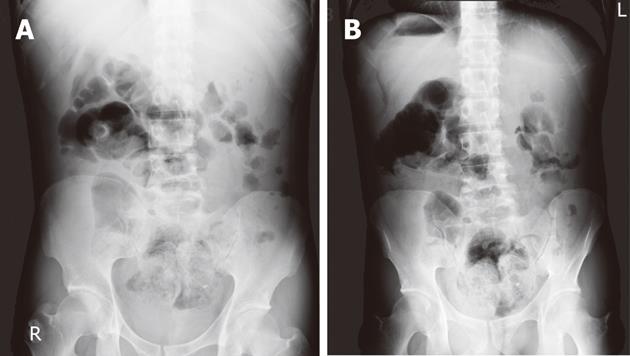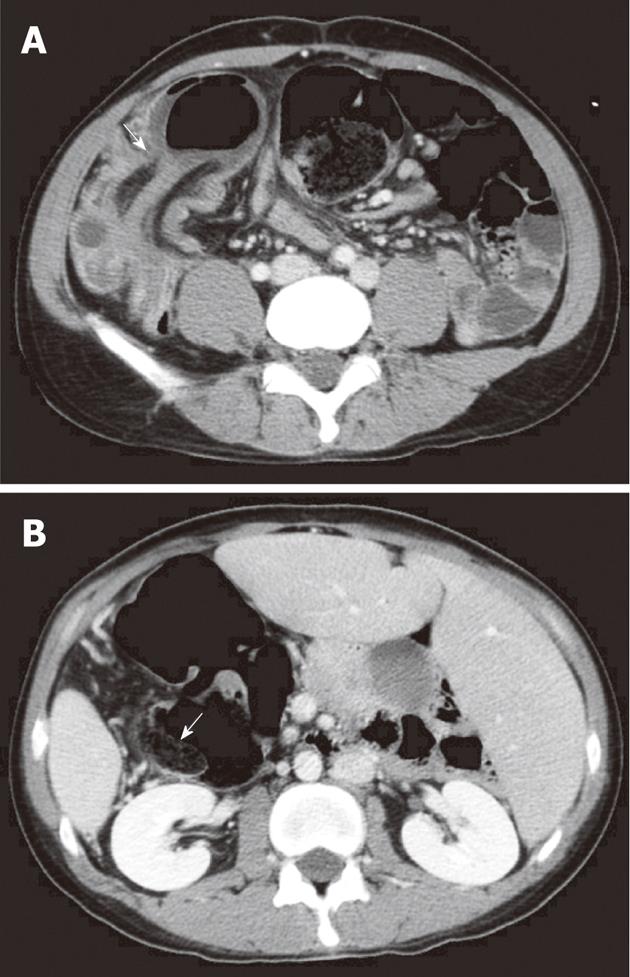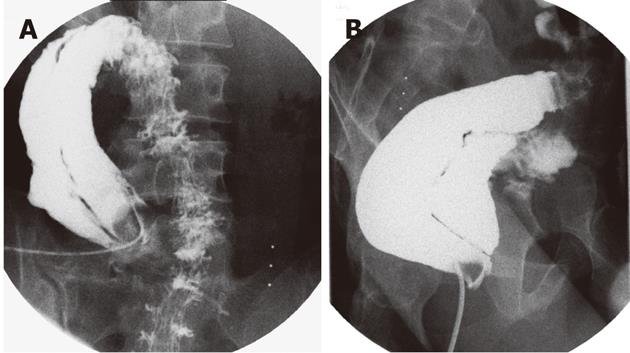Published online Nov 21, 2012. doi: 10.3748/wjg.v18.i43.6338
Revised: June 18, 2012
Accepted: July 9, 2012
Published online: November 21, 2012
Colonic intussusception and gastrointestinal duplication are diseases that arise in young children. The clinical presentation of adult cases of intussusception and enteric duplication is non-specific and thus poses a diagnostic challenge. A computed tomography (CT) scan is recommended in adult cases as the most sensitive diagnostic tool and the pathognomonic finding of outer intussuscepiens and central intussusceptum is diagnostic. A septum of a duplicated colon in a non-intussuscepted segment has been rarely reported in the literature. With advancements in radiological imaging technology and the increased availability of CT scanners, the capacity for a correct pre-operative diagnosis has been significantly enhanced. Our current case report illustrates the importance of considering an uncommon etiology for enteric intussusception and duplication as a differential diagnosis of acute abdomen in an adult patient. Our analyses of this patient also highlight the successful use of CT scanning to make this diagnosis.
- Citation: Ho YC. Total colorectal and terminal ileal duplication presenting as intussusception and intestinal obstruction. World J Gastroenterol 2012; 18(43): 6338-6340
- URL: https://www.wjgnet.com/1007-9327/full/v18/i43/6338.htm
- DOI: https://dx.doi.org/10.3748/wjg.v18.i43.6338
Colonic intussusception and gastrointestinal duplication are diseases of young children. Symptomatic colonic duplication is very rare in adults. We report a case of a young adult patient with a duplication of the terminal ileum, appendix, colon and rectum who presented in our hospital with symptoms of acute intestinal obstruction and intussusception.
A 25-year-old man was admitted to our hospital for central abdominal pain for three days. He had a history of situs inversus and a watery bowel opening with blood streaks was noted on the day of admission. A physical examination revealed a distended abdomen, and tenderness and rebound over the lower abdomen.
Abdominal radiographs further revealed some dilated bowel loops at the right abdomen, which was a relatively non-specific finding (Figure 1). Fresh blood was found in the rectum during a sigmoidoscopic examination. Advancement beyond 30 cm could not be achieved during this examination due to an acute kink. A computed tomography (CT) scan was then performed for further assessment and an intestinal obstruction was confirmed. Intussusception at the region of the sigmoid and descending colon was detected at the right lower abdomen (since the patient had situs inversus) (Figure 2A). The duplicate appearance of the large bowel at the right lower quadrant of abdomen was also noted (Figure 2B).
Emergency surgery was performed and revealed a grossly dilated sigmoid and descending colon. Intussusception into the distal sigmoid colon with a large gangrenous diverticulum formed by the septum of a duplicated colon was also observed. A partial small bowel resection, decompression and a colostomy were subsequently performed.
A post-operative gastrografin enema via the enterostomy and anus further confirmed a duplication of large bowel and terminal ileum in this patient (Figure 3).
Colonic intussusception and gastrointestinal duplication are diseases of young children that usually manifest before two years of age (male:female ratio, 3:1)[1]. Intestinal intussusception in adults is very rare however. In a previously reported surgical series of 20 adults with intussusception, no single diagnosis of gastrointestinal duplication was identified as the underlying pathology[2]. Colonic duplication represents 4%-18% of gastrointestinal duplication cases[3]. Duplications are classified according to location or shape; cystic (more than 80%) or tubular[4]. The classification of this disorder in accordance with the vascular pattern had also been proposed[5].
The clinical presentation of an adult case with intussusception and enteric duplication is typically non-specific, i.e., abdominal pain, nausea and constipation. The mode of presentation can also be acute, subacute or chronic[1].
CT scans are recommended as the most sensitive diagnostic tool in adult cases of intestinal intussusception[1]. The pathognomonic finding of outer intussuscepiens and central intussusceptum confirms the diagnosis of these cases. The complex mass is "sausage-shaped" or "target" like when the CT beam is oriented parallel or perpendicular to its axis, respectively[6]. It can in rare cases present as a cystic mass at the left upper abdomen, thus causing diagnostic confusion as a pancreatic tumor[7]. The diagnosis of enteric duplication in the absence of intussusception or intestinal obstruction is challenging and it is often difficult to do before surgery[1,3]. CT scanning can reveal a cystic mass attached to the colon[3]. The demonstration of a septum of a duplicated colon in a non-intussuscepted segment is a rarity in the current literature.
In summary, our present case illustrates the importance of considering an uncommon etiology involving enteric intussusception and duplication as a potential differential diagnosis for acute abdominal pain in an adult patient. Furthermore, our present findings demonstrate the applicability of a CT scan in making such a challenging diagnosis.
Peer reviewer: Keiji Hirata, MD, Department of Surgery I, University of Occupational and Environmental Health, Yahatanishi-ku, 1-1 Iseigaoka, Kitakyushu 807-8555, Japan
S- Editor Gou SX L- Editor A E- Editor Xiong L
| 1. | Reiser-Erkan C, Erkan M, Ulbrich E, Nährig J, Kleeff J. Cystic colon duplication causing intussusception in a 25-year-old man: report of a case and review of the literature. BMC Surg. 2010;10:19. [RCA] [PubMed] [DOI] [Full Text] [Full Text (PDF)] [Cited by in Crossref: 18] [Cited by in RCA: 21] [Article Influence: 1.4] [Reference Citation Analysis (0)] |
| 2. | Yakan S, Caliskan C, Makay O, Denecli AG, Korkut MA. Intussusception in adults: clinical characteristics, diagnosis and operative strategies. World J Gastroenterol. 2009;15:1985-1989. [RCA] [PubMed] [DOI] [Full Text] [Full Text (PDF)] [Cited by in CrossRef: 111] [Cited by in RCA: 141] [Article Influence: 8.8] [Reference Citation Analysis (0)] |
| 3. | Fotiadis C, Genetzakis M, Papandreou I, Misiakos EP, Agapitos E, Zografos GC. Colonic duplication in adults: report of two cases presenting with rectal bleeding. World J Gastroenterol. 2005;11:5072-5074. [PubMed] |
| 4. | Kekez T, Augustin G, Hrstic I, Smud D, Majerovic M, Jelincic Z, Kinda E. Colonic duplication in an adult who presented with chronic constipation attributed to hypothyroidism. World J Gastroenterol. 2008;14:644-646. [PubMed] [DOI] [Full Text] |
| 5. | Li L, Zhang JZ, Wang YX. Vascular classification for small intestinal duplications: experience with 80 cases. J Pediatr Surg. 1998;33:1243-1245. [RCA] [PubMed] [DOI] [Full Text] [Cited by in Crossref: 22] [Cited by in RCA: 21] [Article Influence: 0.8] [Reference Citation Analysis (0)] |
| 6. | Gayer G, Zissin R, Apter S, Papa M, Hertz M. Pictorial review: adult intussusception--a CT diagnosis. Br J Radiol. 2002;75:185-190. [PubMed] |
| 7. | Carneiro FP, de Nazareth Sobreira M, de Azevedo AE, Alves AP, Campos KM. Colonic duplication in an adult mimicking a tumor of pancreas. World J Gastroenterol. 2008;14:966-968. [RCA] [PubMed] [DOI] [Full Text] [Full Text (PDF)] [Cited by in CrossRef: 3] [Cited by in RCA: 5] [Article Influence: 0.3] [Reference Citation Analysis (0)] |















